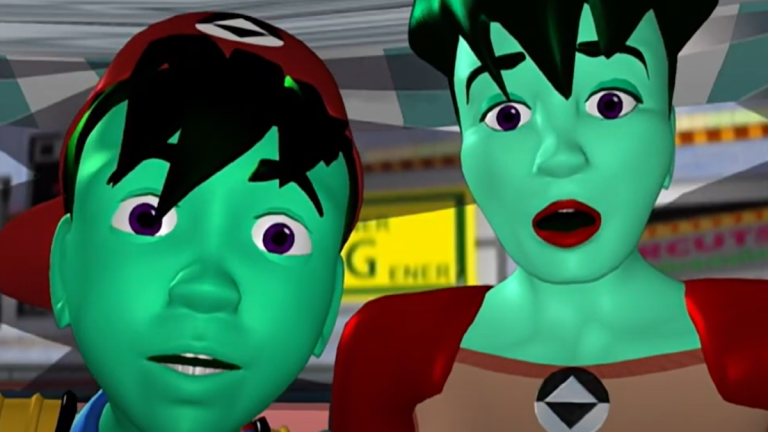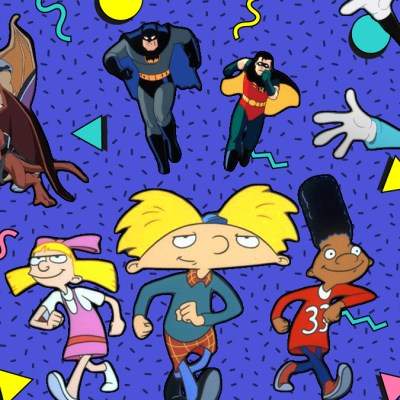ReBoot 30 Years Later: A CGI Kids Show Way Ahead of Its Time
The CGI on '90s animated series ReBoot may not have been ready for primetime, but its storytelling approach was.

Three decades ago, children across the world were enraptured by a screen adventure like nothing they had seen before. Animated entirely using computer-generated imagery (CGI), it showed them a world of inanimate objects given life and personality, and would become an enormous hit that inspired a generation.
This fake-out intro assumes you’ll think we’re talking about the CGI feature film Toy Story, though obviously you’ve seen the headline, so you’ll already know we’re talking about the CGI TV show ReBoot. But it’s a tried and tested format, so let’s just leave it in.
Set inside a computer (for logistical reasons as much as creative ones), ReBoot charted the adventures of Bob, Enzo, Dot, AndrAla and a motley cast of allies and enemies, anthropomorphized “sprites” living in the digital city of Mainframe. Across three seasons and a pair of made-for-TV movies, they would battle evil viruses, Lovecraftian “Web creatures,” and unseen human “Users” whose idle game playing threatened to destroy their pixelated world.
Thirty years on from ReBoot’s debut, here’s why the show was ground-breaking in more ways than one…
Note: This feature refers to articles from LA Times, The Independent and Engadget, and the following archived interviews and press releases.
A Different Time
CGI was by no means an unknown quantity when ReBoot aired its first episode in September 1994. Blockbusters like Terminator 2: Judgment Day and Jurassic Park had shown how spectacularly the emerging technology could be deployed on the big screen, but it had also been used extensively on TV, albeit at a significantly smaller scale. Readers of a certain age may remember the pioneering blend of human contestants and computer-generated environments used in the game show Knightmare, while series like Babylon 5, The Jim Henson Hour and even Live & Kicking made use of CGI, with varying degrees of success.
But employing CGI for incidental effects was one thing. A TV show created entirely on the computer was quite another.
Enter Gavin Blair, Ian Pearson, Phil Mitchell and John Grace, a.k.a. creative team The Hub. Initially based in the U.K., Blair and Pearson had been working with CGI since the ‘80s, with the iconic video for Dire Straits’ 1985 single “Money For Nothing” probably their most widely seen creation.
Even during that early period, the team were kicking around ideas for a fully CGI-animated TV show, with the conceit of setting the series inside a computer present pretty much from the get-go, as a way of explaining the characters’ primitive, blocky appearances. By the time the technology had improved enough to create more life-like characters, they had developed their computer world much further, and stuck with it for artistic reasons.
Read more
You’ll notice that nearly a decade passed between the initial inception of the idea and ReBoot’s debut. Not only was the technology simply not ready in 1985, but just developing the concept was prohibitively expensive – the team didn’t have access to the equipment they needed, and importing it into the U.K. was a financial impossibility.
However, such equipment was more easily available in Canada – along with lucrative tax breaks and various other subsidies. So the team made the move across the Atlantic to Vancouver to start seriously developing their idea. But even then, the process was far from simple. The team lacked the funds to create a pilot to show to networks, and had to rely largely on the power of persuasion. With no real proof of concept, merely ambitious promises about what the team could create, given the money, many networks understandably balked.
Eventually, however, the team managed to persuade ABC TV – along with a complex web of international co-financiers – to take the million-dollar gamble. And the rest is… quite complicated history.
The Tech
Created by The Hub’s newly founded animation studio Mainframe Entertainment, ReBoot’s 13-episode first season cost $10 million to produce (something like $21 million in 2024, adjusted for inflation). The costs were mainly down to the up-front investment in equipment and software – it was largely made using Softimage Creative Environment, the same software used by Industrial Light and Magic to bring Jurassic Park’s dinosaurs to life, but Mainframe also had to create its own proprietary software to supplement this. Initially, a single episode of the show took 18 weeks to complete, but with the help of their new in-house software, the team managed to bring this down to less than eight weeks.
Even the show’s more visually sophisticated later seasons look pretty quaint by modern standards, but it’s important to remember that nothing like this had been done before. By the same token, however, it’s also worth noting that Mainframe weren’t the only team trying to do what nobody else had done before. Serendipitously, another fully CGI-animated TV show made its debut the same year as ReBoot – Insektors, created by French studio Fantôme.
But while the technology was cutting-edge, ABC’s anxiety about its investment meant that ReBoot’s storylines took longer to realize their full potential.
The Writing
Mainframe were at loggerheads with ABC’s internal Broadcast Standards and Practices (BSP) department from the beginning. Despite the fact that the action-packed Teenage Mutant Ninja Turtles and Power Rangers were enormously popular with the child demographic that ReBoot was targeting, BSP frequently nixed even mild displays of violence – which proved a problem when it came to Bob, the ostensible main character of the show, who was supposed to be a physically capable action hero. Jokes were also frequently cut, though the team still managed to sneak in plenty of pop culture references and gags for adult viewers who might have been watching with their children, even lampooning BSP itself in the episode “Talent Night.”
But it went further than that. Even mild peril was often out of the question for BSP – it was thought that if the characters were in too much jeopardy when the show cut to commercials, this would worry children, which meant no act break cliffhangers. U.K. readers might be reminded of infamously censorious TV campaigner Mary Whitehouse, who had a similarly patronizing and nonsensical view of children’s media literacy.
On top of all these restrictions – which included altering the look of Dot, a fairly normally proportioned woman, so that she had a triangular “monobreast” that wouldn’t give children ideas – ABC also wanted fully standalone episodes, with no complicated storylines. This was arguably a more understandable diktat, as arc-based storytelling was by no means common on television at the time, even in shows for adults.
But the ReBoot team had big plans. And after two seasons chafing against the requirements of BSP, they managed to implement a season-ending story arc involving the infiltration of Mainframe by a creepy Web creature, culminating in an all-out war for the city. Season 2 even ended on a major cliffhanger, as heroic Guardian Bob was imprisoned by the treacherous virus Megabyte and sent off into the Web, leaving kid sidekick Enzo to carry his mantle.
It was dramatic stuff, and for many younger viewers, their first brush with both serialized TV storytelling and high stakes action. The creators, their confidence boosted by the show’s enthusiastic reception, had grown bolder, and with the threat of cancellation hanging over them, they’d stopped pulling their punches.
But the threatened cancellation didn’t materialize – in fact, the show was granted a major reprieve.
Off the Leash
After two seasons, Mainframe parted ways with ABC. Luckily for them, ReBoot had been a big hit in both North America and overseas, and numerous networks were keen to purchase it for syndication.
Free of the shackles of BSP, and boasting numerous technical improvements like enhanced shadows and character detail, ReBoot’s third season was arguably the show that the creators always dreamed of making. The story arc that began in the second season became more complex, with Enzo – drafted into the Guardians by Bob before the hero’s forced exile – feeling the pressure of defending Mainframe from viruses and games. Those games, which had always been fun but generic takes on existing formats, became more specific parodies, including an extended riff on the Evil Dead films that would likely have given ABC conniptions. Another episode lovingly homaged classic Warner Bros. cartoons, while James Bond riff “Firewall” even had its own parody Bond theme, written and performed in the style of Shirley Bassey’s iconic “Goldfinger.”
Season 3 also took plenty of storytelling risks. Enzo and his friend AndrAla, both of whom had always been cute, immature audience identification figures, were unexpectedly defeated by the User in a Mortal Kombat-esque game, ending up lost on the Net. Even more shockingly, due to time moving differently outside of Mainframe, the characters aged into adults – literally between episodes. One week, you were watching two kids with whom you’d spent multiple seasons. The next, they were suddenly grizzled adults fighting their way through increasingly bizarre worlds – including one particularly mind-bending riff on The Prisoner, of all things.
This was pretty unprecedented stuff for kids TV, and fairly mind-blowing for a young audience. The show had come a long way from the brightly colored, sanitized standalone adventures of the early seasons – though the team never forgot that ReBoot was supposed to be fun, balancing the darker, more mature storytelling with plenty of jokes. The general quality of the writing also improved, as the team drafted in experienced comic book scribes like Marv Wolfman, Lein Wein and Dan DiDio, and even legendary scriptwriter D.C. Fontana – who penned one of season 3’s highlights, “Where No Sprite Has Gone Before,” an affectionate mashup of Star Trek and superhero comics.
But sadly, despite the dramatic highs of the third season finale, the future of ReBoot would be bumpy at best.
Season 4, Reboots, and Beyond
Accounts of the production process for ReBoot’s troubled fourth – and final – season vary. But in broad terms, a mixture of budgetary concerns, changing deals, and cuts imposed from on high resulted in a fractured process, with much material being cut. Two TV movies were eventually produced, chopped roughly into shorter episodes to be broadcast on Cartoon Network, with the season ending on a cliffhanger.
A cliffhanger that was, sadly for fans, never to be resolved.
While certainly an inauspicious end for the series, it was also oddly fitting. From the very beginning, ReBoot defied the odds, and much of its early life was spent fighting both technological limitations and the demands of those holding the purse strings. Its third season showed the heights the show was capable of hitting, but the fourth was once again a product of conflict and compromise.
There has been very little new or supplementary ReBoot content since those last TV movies aired in 2001, save a few webcomics. Some TV and big screen spin-offs have entered development before being quietly canceled, and the only major offering to see the light of day was a 2015 Netflix-produced reimagining, ReBoot: The Guardian Code. A hybrid of live action and CGI animation, this ReBoot reboot was so egregiously bad that there has been an unspoken collective agreement among both fans and casual viewers to forget that it ever existed.
It might simply be that the show belongs in the past. Produced at just the right moment in the evolution of computer animation, and at a time when personal computers were becoming ubiquitous enough for the average viewer to understand jargon like “mainframe,” “hack,” and “megabyte,” it was a passion project for young, hungry creators pushing against financial, technical and artistic limits.
And for those lucky enough to enjoy it at the time, it truly was like nothing we’d ever seen before.
ReBoot is available to stream on Prime Video, Crunchyroll, and Tubi in the U.S and Crunchyroll in the U.K.

